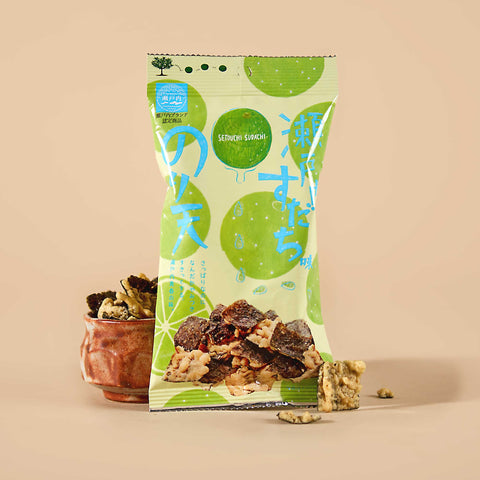A Guide to Japanese Monsters: Kuchisake Onna
Welcome to the latest installment of Bokksu’s Guide to Japanese Monsters, your source for all beings spooky, scary, syncretic folk religious, sneaky, and sometimes even “on your side.” We’ve been reporting on the seemingly boundless world of…what should we call them? “Japanese monsters”? Or “Japanese mythical creatures?” Would “Japanese mythological creatures” do the trick? Well, no matter. Today we’ll be talking Kuchisake Onna, whose name in translation (split-mouthed woman) whose name sums up her visage handily. If you’re new to Bokksu, we are the Japanese snack box, but we’re more than mouths (get it?) and stomachs! To wit: this note on Kuchisake Onna. Japanese monsters make for pretty good Halloween costumes and nighttime campfire reads. So today, we throw some Japanese candy and Japanese snacks into your goodie bags. Stay tuned, if you’re ready for things to get sinister. If at any point you lose your popcorn, you can always order some curated Japanese sweets
A Foggy Mountain Forest, Filled with Japanese Mythological Creatures
In previous Guides to Japanese Monsters (aka Japanese Mythological Creatures, aka Japanese Mythical Creatures), we’ve addressed just why there are so many of these beings, and where they come from. The short of it: many pre-Buddhist Japanese spiritual and religious beliefs already involved pantheons of gods and mythical beings. Upon their arrival, figures from Buddhist texts folded easily into these belief systems. In addition to the combination (and sometimes blurring) of Buddhist and Shinto spiritual figures, emerged folk characters from old stories and legends. Then there is Japan’s dominant worldview: animism, in which a rock, lantern, or even an entire garden holds some spiritual essence or even sentience. Last, some Japanese monsters and other Japanese mythological creatures were sprung from the imaginations of individual writers and visual artists! Over the course of many centuries, public interest in yokai, ghosts, and other Japanese mythical creatures has given rise to illustrated scrolls, newspaper and magazines features, television programs, and even films. Kuchisake Onna is just one of many with real staying power.
Who is Kuchisake Onna?
Our “slit-mouthed woman” falls under the category of yuurei, a ghost caught between its human life and the afterlife due to some wrongdoing on Earth, e.g. incorrect burial rites or a conflict that has gone unresolved. Typical of yuurei, Kuchisake Onna wears white clothing, a color associated with death and funerals. She is described as having pale skin with long, dark hair. When her mouth scars are covered, Kuchisake Onna is also often described as being very beautiful.
So, you ask, why is she still here? Kuchisake Onna is back for revenge. When discovered to be having an affair, the story goes, her husband disfigures her, asking, “Who will think you’re beautiful now?” She dies soon after, only to return to the physical plane, asking any who cross her path, “Do you think I’m beautiful?” In tales of old, she held a fan or scarf to her face to hide her scars. In recent decades, she is said to wear a surgical mask.
Real-life Panic
Curiously, Kuchisake Onna seeks the approval not of men, but of children. There is no right answer to Kuchisake Onna’s question. If one answers “yes,” she reveals her mouth and asks once more. Regardless of the reply, she’ll kill her interlocutor, either on the spot or later in their bed. Like other onryo (for this is Kuchisake Onna’s specific type of yuurei), she is capable of exacting harm on living beings. In 1979, Kuchisake Onna created a kind of localized hysteria among schoolchildren. The trouble grew so serious that students had to be escorted in groups to and from school. As these things do, the panic eventually faded. In the meantime, the children had invented another response to Kuchisake Onna’s question: distraction by tossing Japanese candy. But what Japanese sweets are powerful enough to confuse an immortal murderer?
Japanese Snacks to the Rescue
Bokksu is known as the premier Japanese snack subscription box dedicated to creators of traditional Japanese snacks and sweets. This is key, because if there are any traditional Japanese sweets that can take out a traditional ghost, it’s probably something you can get only at Bokksu. Consider the Daimonji Ame Honpo collab Handmade Sakura Candy: if cherry blossoms represent the ephemerality of life, think of how powerful these exclusive hard candies would be when pelted at someone who just can’t let go!

Want to fly in the face of Kuchisake Onna’s false sweetness?Try some savory Japanese snacks like Seaweed Tempura with Sudachi

or Uni (sea urchin) Rice Crackers.

They’ll be hard to part with, but scatter some on the ground, and their satisfying crunch will warn you of approaching footsteps. We have all kinds of delection-protections a la carte Marketplace or delivered in our monthly Japanese candy box. But be warned, fair reader. Once you’ve had a taste, you may find that our Japanese snacks are, quite literally, to die for.
Author Bio























